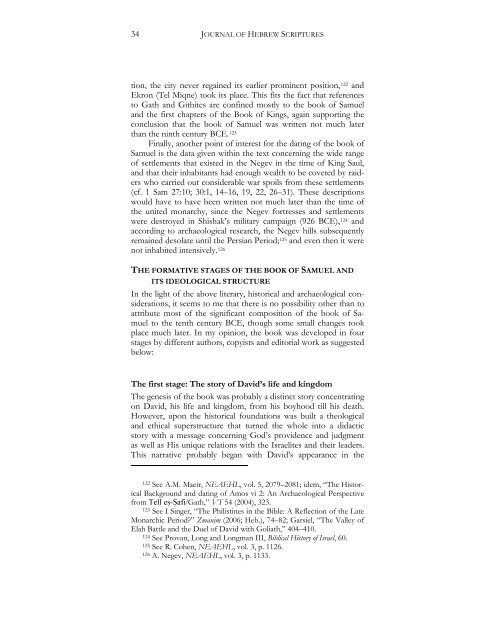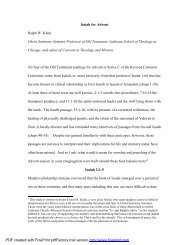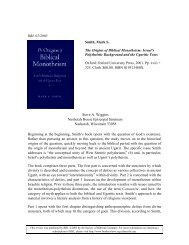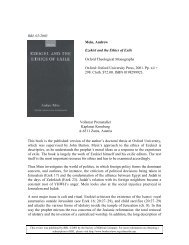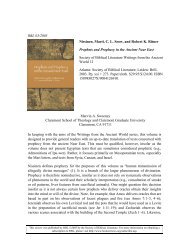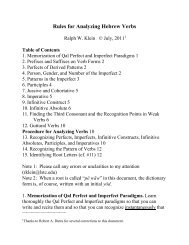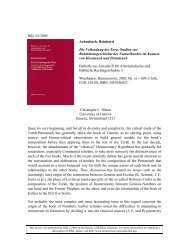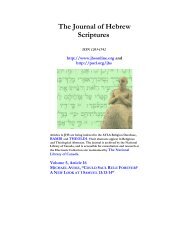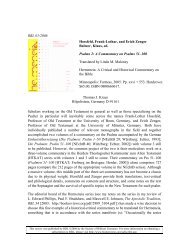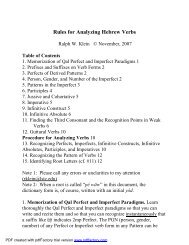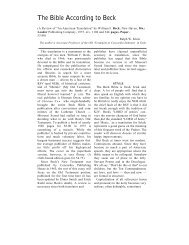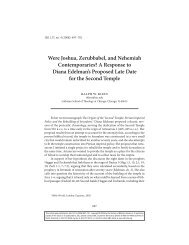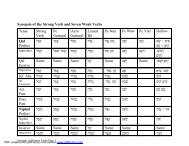The Book of Samuel: Its Composition, Structure and Significance as ...
The Book of Samuel: Its Composition, Structure and Significance as ...
The Book of Samuel: Its Composition, Structure and Significance as ...
Create successful ePaper yourself
Turn your PDF publications into a flip-book with our unique Google optimized e-Paper software.
34 JOURNAL OF HEBREW SCRIPTURES<br />
tion, the city never regained its earlier prominent position, 122 <strong>and</strong><br />
Ekron (Tel Miqne) took its place. This fits the fact that references<br />
to Gath <strong>and</strong> Githites are confined mostly to the book <strong>of</strong> <strong>Samuel</strong><br />
<strong>and</strong> the first chapters <strong>of</strong> the <strong>Book</strong> <strong>of</strong> Kings, again supporting the<br />
conclusion that the book <strong>of</strong> <strong>Samuel</strong> w<strong>as</strong> written not much later<br />
than the ninth century BCE. 123<br />
Finally, another point <strong>of</strong> interest for the dating <strong>of</strong> the book <strong>of</strong><br />
<strong>Samuel</strong> is the data given within the text concerning the wide range<br />
<strong>of</strong> settlements that existed in the Negev in the time <strong>of</strong> King Saul,<br />
<strong>and</strong> that their inhabitants had enough wealth to be coveted by raiders<br />
who carried out considerable war spoils from these settlements<br />
(cf. 1 Sam 27:10; 30:1, 14–16, 19, 22, 26–31). <strong>The</strong>se descriptions<br />
would have to have been written not much later than the time <strong>of</strong><br />
the united monarchy, since the Negev fortresses <strong>and</strong> settlements<br />
were destroyed in Shishak’s military campaign (926 BCE), 124 <strong>and</strong><br />
according to archaeological research, the Negev hills subsequently<br />
remained desolate until the Persian Period; 125 <strong>and</strong> even then it were<br />
not inhabited intensively. 126<br />
THE FORMATIVE STAGES OF THE BOOK OF SAMUEL AND<br />
ITS IDEOLOGICAL STRUCTURE<br />
In the light <strong>of</strong> the above literary, historical <strong>and</strong> archaeological considerations,<br />
it seems to me that there is no possibility other than to<br />
attribute most <strong>of</strong> the significant composition <strong>of</strong> the book <strong>of</strong> <strong>Samuel</strong><br />
to the tenth century BCE, though some small changes took<br />
place much later. In my opinion, the book w<strong>as</strong> developed in four<br />
stages by different authors, copyists <strong>and</strong> editorial work <strong>as</strong> suggested<br />
below:<br />
<strong>The</strong> first stage: <strong>The</strong> story <strong>of</strong> David’s life <strong>and</strong> kingdom<br />
<strong>The</strong> genesis <strong>of</strong> the book w<strong>as</strong> probably a distinct story concentrating<br />
on David, his life <strong>and</strong> kingdom, from his boyhood till his death.<br />
However, upon the historical foundations w<strong>as</strong> built a theological<br />
<strong>and</strong> ethical superstructure that turned the whole into a didactic<br />
story with a message concerning God’s providence <strong>and</strong> judgment<br />
<strong>as</strong> well <strong>as</strong> His unique relations with the Israelites <strong>and</strong> their leaders.<br />
This narrative probably began with David’s appearance in the<br />
122 See A.M. Maeir, NEAEHL, vol. 5, 2079–2081; idem, “<strong>The</strong> Historical<br />
Background <strong>and</strong> dating <strong>of</strong> Amos vi 2: An Archaeological Perspective<br />
from Tell eṣ-Ṣafi/Gath,” VT 54 (2004), 323.<br />
123 See I Singer, “<strong>The</strong> Philistines in the Bible: A Reflection <strong>of</strong> the Late<br />
Monarchic Period?” Zmanim (2006; Heb.), 74–82; Garsiel, “<strong>The</strong> Valley <strong>of</strong><br />
Elah Battle <strong>and</strong> the Duel <strong>of</strong> David with Goliath,” 404–410.<br />
124 See Provan, Long <strong>and</strong> Longman III, Biblical History <strong>of</strong> Israel, 60.<br />
125 See R. Cohen, NEAEHL, vol. 3, p. 1126.<br />
126 A. Negev, NEAEHL, vol. 3, p. 1133.


